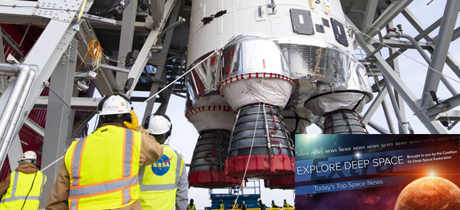In Today’s Deep Space Extra… NASA’s Space Launch System (SLS) core stage continues to make “Green Run” progress. Near Earth Objects (NEOs) are a passing concern.
Human Space Exploration
Green Run testing enters home stretch, countdown simulation to begin NET 19 September
Coalition Members in the News – Aerojet Rocketdyne, Boeing, Northrop Grumman
AmericaSpace.com (9/11): At NASA’s Stennis Space Center in Mississippi, workers are striving toward a milestone “Green Run” ground test of the Space Launch System (SLS) core stage in which all four RS-25 engines would fire for a full duration of eight minutes. The test could come as soon as next month, despite challenges presented by powerful hurricane Laura, other tropical storms and the coronavirus pandemic. Once the current series of eight ground tests is complete, the core stage moves on to the Kennedy Space Center (KSC) for the launch of Artemis 1, an uncrewed test flight of the SLS and Orion crew capsule, currently planned for next year.
Space Science
Should we be looking harder for asteroids? Mystery space rock could have caused ‘global devastation’
Forbes (9/13): Last week, an amateur astronomer in Brazil spotted a previously undiscovered asteroid that passed within 25 million miles of Earth. Though not a threat, 2020 QU6 was more than a half-mile wide and its late discovery raises a concern over the potential of space objects like it to cause widespread impact damage and whether the world’s current planetary defense measures are sufficient. With sufficient funding, NASA plans to launch the Near Earth Object (NEO) Surveillance mission in 2025 and prior to that the Double Asteroid Redirect Mission to demonstrate a strategy for changing the course of an asteroid that could impact.
The EmDrive just won’t die
Popular Mechanics (9/11): The Defense Advanced Research Projects Agency, DARPA, is “go” to continue studying the prospects of a theoretical EmDrive rocket propulsion technology, using microwaves or laser light energy.
How to see Uranus in the night sky (without a telescope) this week
Space.com (9/11): Though 1.77 billion miles from the sun, it’s possible to spot Uranus in the late night/early morning sky without a telescope as the Moon dims. The large planet is just east of Mars in the constellation Aries, the Ram. The article offers help of where and how to look. Binoculars would help.
Other News
Bolden talks expectations for Biden’s space policy
Coalition Member in the News – Boeing
Politico (9/11): Charles Bolden, NASA’s administrator during the Obama Administration, offers some predictions regarding NASA, if former Vice President Joe Biden is elected U.S. president in November. While not making dramatic changes in its course, NASA will take on more of an Earth science focus, Bolden suggests. The commercial launch industry can now provide alternatives to NASA’s Space Launch System (SLS) for human deep space exploration, which has yet to launch after more than a decade of development. NASA will be led by its first woman administrator, Bolden also predicts.
Congress set to pass space weather bill
SpaceNews.com (9/13): Under a suspension of the rules, the U.S. House is scheduled to vote Wednesday on PROSWIFT, legislation codifying elements of a space weather action plan involving research of and monitoring of solar activity and provide warnings of conditions that could threaten satellites and ground based assets, including power grids. The legislative effort dates to 2015. The U.S. Senate passed the measure, S. 881, on July 27. House passage would send the bill to the president for signature.
‘We’ll be back’ – rocket launch from Alaska fails to reach orbit
Forbes.com (9/12): Small rocket launch services provider Astra, of Alameda, California, failed in its first launch attempt from Alaska. The first stage of the two-stage rocket appeared to shut down due to a guidance issue. Astra plans to launch again soon in a bid to achieve orbit within three launches.
China is building a floating spaceport for rocket launches
Universe Today (9/10): China is currently developing an offshore launch complex, the Eastern Aerospace Port, off the coast of Haiyang. As China’s fifth launch facility, it would become part of Beijing’s advancing space stature.
Chinese Kuaizhou-1A rocket launch ends in failure
SpaceNews.com (9/12): Chinese authorities are investigating the failed launch of a Kuaizhou-1A solid rocket early Saturday carrying a high resolution Earth observation satellite, the Jilin-1 Gaofen 02C. It was the fourth time a Chinese rocket has failed so far in 2020 in 26 launch attempts.
Toledo airport now bears name of NASA’s Kranz
Toledo Blade of Ohio (9/11): Toledo’s main airport now features the name of Gene Kranz, NASA’s lead flight director for the Apollo 11 and 13 missions, and a Toledo, Ohio native. A dedication ceremony is planned for the spring of 2021.
Major Space Related Activities for the Week
Major space related activities for the week of September 13-19, 2020
Spacepolicyonline.com (9/13): Lots in the way of virtual space policy planned for this week. The U.S. House and Senate are in session for most of the week and it appears the 2021 fiscal year that gets underway October 1 will be under a “clean” continuing resolution that extends spending for weeks, possibly months without a formal federal budget. NASA Administrator Jim Bridenstine is to address the Lunar Exploration and Analysis Group on Monday at 10:40 a.m., EDT, part of the start of a three-day LEAG virtual meeting. The session is focused on the value of a sustained human presence on the Moon. The National Academies’ Committee on Astrobiology and Planetary Science (CAPS) meets Wednesday. On Friday, the National Academies’ new Committee on Planetary Protection meets for a second time to discuss protection measures for the Moon. Also Friday, the U.S. House Science, Space, and Technology Committee’s Space and Aeronautics subcommittee hosts a virtual hearing entitled, “Cybersecurity at NASA: Ongoing Challenges and Emerging Issues for Increased Telework During COVID-19.”

